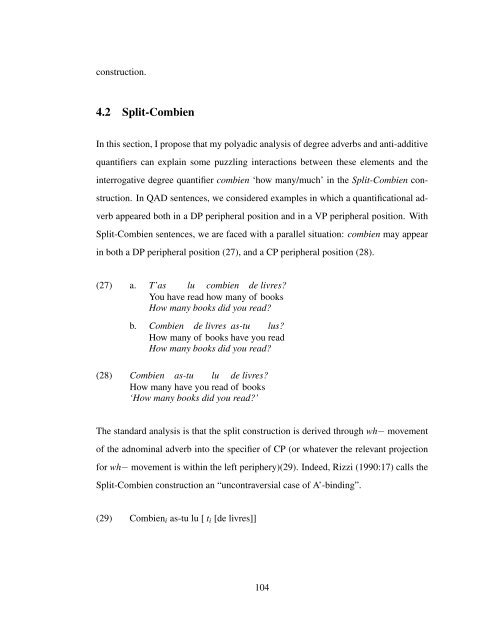Formal Approaches to Semantic Microvariation: Adverbial ...
Formal Approaches to Semantic Microvariation: Adverbial ...
Formal Approaches to Semantic Microvariation: Adverbial ...
You also want an ePaper? Increase the reach of your titles
YUMPU automatically turns print PDFs into web optimized ePapers that Google loves.
construction.<br />
4.2 Split-Combien<br />
In this section, I propose that my polyadic analysis of degree adverbs and anti-additive<br />
quantifiers can explain some puzzling interactions between these elements and the<br />
interrogative degree quantifier combien ‘how many/much’ in the Split-Combien construction.<br />
In QAD sentences, we considered examples in which a quantificational adverb<br />
appeared both in a DP peripheral position and in a VP peripheral position. With<br />
Split-Combien sentences, we are faced with a parallel situation: combien may appear<br />
in both a DP peripheral position (27), and a CP peripheral position (28).<br />
(27) a. T’as lu combien de livres?<br />
You have read how many of books<br />
How many books did you read?<br />
b. Combien de livres as-tu lus?<br />
How many of books have you read<br />
How many books did you read?<br />
(28) Combien as-tu lu de livres?<br />
How many have you read of books<br />
‘How many books did you read?’<br />
The standard analysis is that the split construction is derived through wh− movement<br />
of the adnominal adverb in<strong>to</strong> the specifier of CP (or whatever the relevant projection<br />
for wh− movement is within the left periphery)(29). Indeed, Rizzi (1990:17) calls the<br />
Split-Combien construction an “uncontraversial case of A’-binding”.<br />
(29) Combien i as-tu lu [ t i [de livres]]<br />
104
















